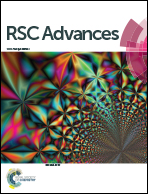Green biorefinery — the ultra-high hydrolysis rate and behavior of Populus tomentosa hemicellulose autohydrolysis under moderate subcritical water conditions†
Abstract
A high monosaccharide conversion rate of hemicellulose in a green solvent and under moderate reaction conditions for industrialization is one of the most important keys in a lignocellulosic biorefinery. The behavior of Populus tomentosa hemicellulose polysaccharides, crystallinity and the furfural formation in the autohydrolysis process under moderate subcritical water conditions (160–180 °C, 0.618–1.002 MPa) were studied. The results have shown that the hemicellulose was converted to corresponding monosaccharides at an ultra-high hydrolysis rate. Factor analysis indicates that the temperature is the most important factor affecting hemicellulose autohydrolysis. When the autohydrolysis temperature increased from 160 to 180 °C for 2 h, the hydrolysis rate of xylose, rhamnose, galactose, mannose, and glucose from hemicellulose increased from 70% to 91%, 71% to 100%, 82% to 95%, 42% to 58%, and 34% to 37%, respectively. Arabinose was completely dissolved in 30 min. The xylose, rhamnose, galactose, and arabinose from hemicellulose could be almost completely removed under the conditions. The hemicellulose removal rate obtained herein exceeded the values reported for most acid, alkali, ionic liquid, or deep eutectic solvent treatments. It is notable that almost all glucose in hemicellulose was dissolved and the glucose in cellulose was partially hydrolyzed. An analysis of the sugar composition and the crystallinity change in the process at 180 °C demonstrate that hydrolysis reaction started to shift from amorphous regions to crystalline regions, due to the partial hydrolysis of crystalline cellulose after 90 min at 180 °C. Overall, these results show that the moderate subcritical water autohydrolysis of hemicellulose in Populus tomentosa may be a potential bio-refinery process.



 Please wait while we load your content...
Please wait while we load your content...